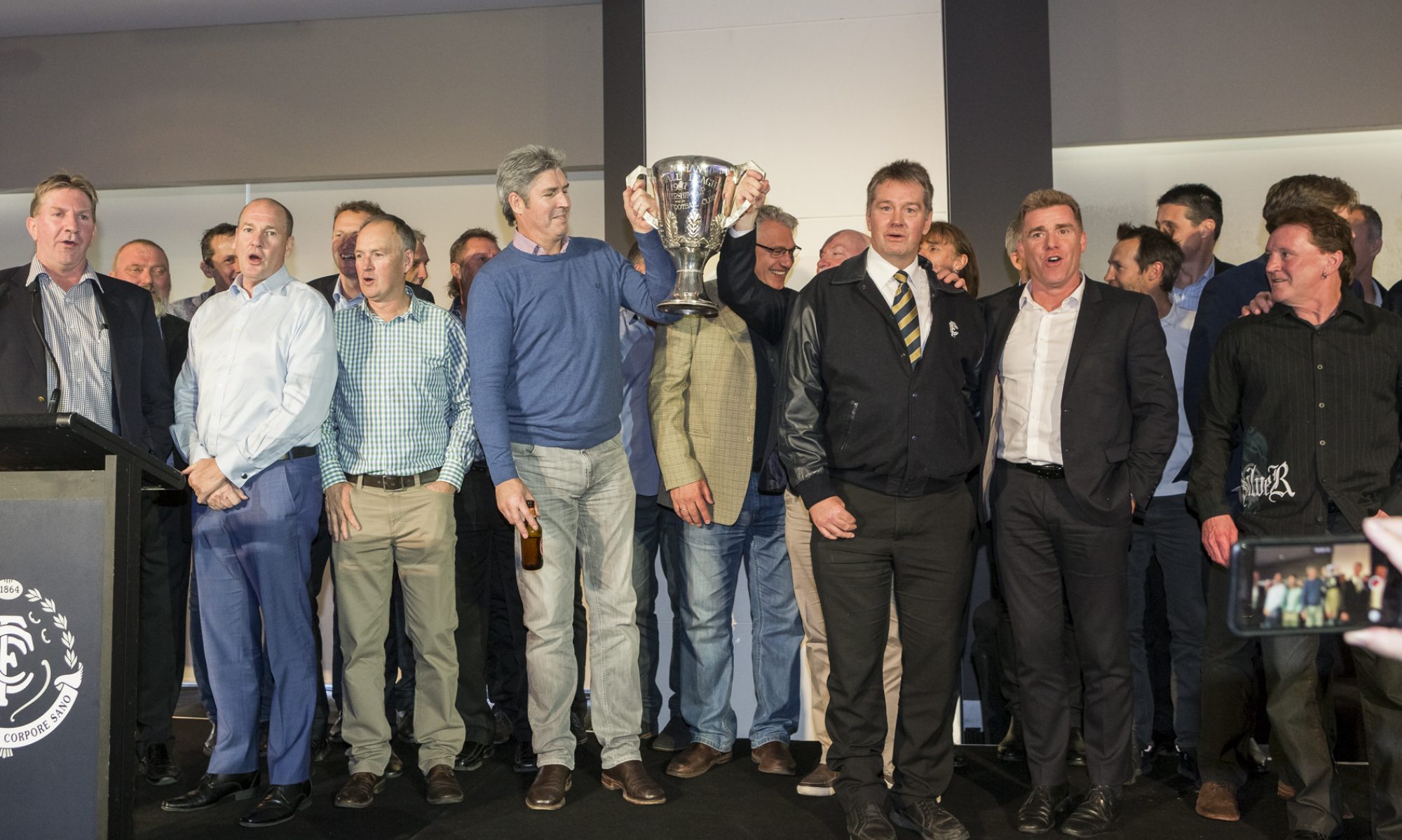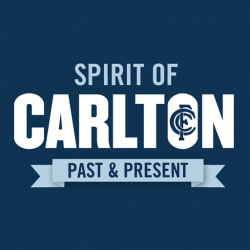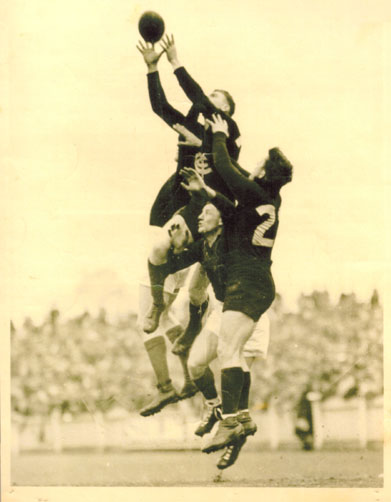Many happy returns to the following past players for their birthdays for the remainder of the month.
March 26th
Jon McCormick
Jon McCormick had a brief but thought provoking stay at Carlton. A great performer in the Murray league, McCormick was touted as a North rookie but Carlton snapped him up in the Rookie Draft nice & early, presumably on Pagan’s advice from their shared North days. McCormick had been recruited from the Murray Kangaroos, after stints with the Murray Bushrangers U/18’s and Wangaratta.
Given the #41, McCormick had a promising pre-season and was promoted for Round 1 of the year. And he made a huge impression, earning 19 stats and kicking 2 goals (with his first two kicks) as the Blues crashed to a large loss against the Swans. One of those goals was a pearler of a right foot snap, and it seemed that McCormick was a diamond in the rough that would help us through our draft penalties.
A right-footer, McCormick is also well remembered for his hairstyles which prompted many nicknames in the crowd. “Rockin’ Roddy” was one of my favourites, after his likeness for crooner Rod Stewart. As a player, his key strength was ball winning ability but he did not have a large frame or super strength to back it up, more relying on skill and footy smarts to get the ball out. His preferred right produced the odd grubber too.
He would play 21 games in 2003 and was presumably setting himself up for a permanent midfield role. Within the season were some stellar games, including a 26 stat game against the Bulldogs. Averaging 13.9 possessions a game, it seemed as though 2004 would be another strong year.
But McCormick would only play 5 games in 2004 as Pagan chose to prefer other players. With limited game time in those games, he would fail to gather more than 8 possessions and could only do one thing – excel at VFL level to try to get another crack. But he was delisted at the end of the 2004 season, after 26 games in the Navy Blue.
From: http://www.blueseum.org/tiki-index.php?page=Jonathon+McCormick
March 28th
Luke O’Sullivan

The story of Luke “Rhino” O’Sullivan is a pearler – was on the list for almost a decade, and only managed to reach his 50th game in his last year. A unique player, O’Sullivan was a 182cm barrel-chested, feet-pumping forward pocket / flanker who loved a goal. He was recruited from the Blues U/19’s, after originally playing for Xavier College (Kew) despite signing on for Footscray where his cousin Shane O’Sullivan had moved to a few years earlier.
Luke also had another brother affiliated with the Blues, older brother Brendan O’Sullivan played Reserve Grade footy with the Blues from 1978 to 1980, he was also later to be the Runner for the Senior team.
Wearing the #27, Rhino had these fantastic side-burns that he wore with pride. His signature move was to take a bounce, rock on to his left foot (preferred) and try to run through tackles. He gave away his fair share of holding the ball free kicks, but also ran over a few opponents. He was a unique player, a player with flair, and clearly a player the Blues loved to keep around despite injury.
First playing in 1988, and perhaps most memorable for a 4 goal burst in Round 6, 1992, O’Sullivan would ironically be delisted after his best year of football, 1997. In the 4 years up to 1997, Rhino would manage 0, 2, 6 and 1 game respectively, due to injury and our strong team a the time. Doing his knee at Waverley didn’t help – remember the surface giving way when he was wearing number 60 in the 1993 ‘Night’ game against Footscray when the Club left his jumper back at Carlton?
1997 was Rhino’s year. 15 games, kicking 12 goals 7 from the flank and occasional midfield role, provided a lot of enjoyment to the fans as Carlton slid out of the finals. Two cracking games – Round 9 versus Freo (26 stats, 2 goals) and Round 11 versus Brisbane are appropriate highlight packages for the man we all loved, the man we all wanted to succeed, the man with the sidies – “Rhino”.
Luke O’Sullivan is the uncle of Sydney Swans youngster Daniel Hannebery.
From: http://www.blueseum.org/tiki-index.php?page=Luke+O%27Sullivan
March 29th
Simon Verbeek
Simon Verbeek was a football journeyman. From his hometown at St Arnaud, he played in a Richmond 1985 U/19’s premiership, the next two seasons he played reserve grade football with the Tigers. He was then cut from the final list and then crossed to VFA club Oakleigh, Richmond again him and invited him to Punt Road for 1988 pre-season, but he was unable to break into the Tigers’ senior team. His coach at Oakleigh, was ex Blues premiership winger, Bryan Quirk, he notified Carlton and the Blues invited Verbeek to Carlton for a tryout.
The Blues gave him that opportunity by recruiting him with selection 12 in the 1989 Pre-Season Draft, and Verbeek responded with a solid debut season to win our Best First Year Player award. Verbeek’s strength was he had a good set of hands and was very strong overhead.
From then on, Simon always seemed to be on the verge of a good career, but unfortunately couldn’t take the extra step required to become an established League footballer. He spent three seasons at Princes Park, and despite occasional flashes of brilliance, was delisted in 1991.
Verbeek also played for the Victorian U/17’s team in 1984.
From: http://www.blueseum.org/tiki-index.php?page=Simon+Verbeek
March 30th
Adrian Hickmott

Adrian Hickmott was a tough, hard-at-it and fair right foot utility who would play 134 games for the Blues between 1996 and 2003. Hickmott would play mainly as a forward with the occasional stint at half-back, and was renowned for his fearlessness and toughness at the ball.
Hickmott started off as a Cat and played 50 games and scored 24 goals, including Geelong’s 1995 Grand Final loss to Carlton, where it must be said he was one of the better players and arguably had the better of Ang Christou by leading hard all day. Whilst the Cat’s big named forwards like Ablett, Brownless and Handley were all being swamped by the Blues defence, this red-head in hoops kept on bobbing up.
Come season’s end, Hickmott would find his way to the Blues in a 3-way trade including draft picks to Carlton, with Troy Bond leaving the Blues for Adelaide. Whether it was his floppy boyish red hair, or his slightly different kicking action, few at Carlton realised how tough and courageous young Hicky was; but over his 8 year career with the Blues he would demonstrate it over & over again.
“Hicky” would make an immediate impact in his new number 9 guernsey with 22 games and 17 in 1997, before a serious knee injury deprived Hickmott of then entire 1998 season. But he would return in 1999 and play all but 2 games from Round 7. A hamstring strain would force him to miss the Preliminary Final but he would be immediately recalled for the Grand Final.
But it would be 2000 and 2001 where we would see the best of Hickmott, with 21 and 23 games respectively and 20 + goals each year.
Hickmott’s fearless attitude to the ball and cheeky grin would endear himself to the Carlton crowd, even if he had come from another club. Some mindless marking attempt where he would be knocked out only added to the cause. His courage and desire led Hickmott to be appointed as Deputy Vice Captain for the Blues between 2002 and 2003.
But Hickmott would retire in Round 16 of 2003 due to a serious groin injury, which had plagued him all year.
Hickmott’s retirement, together with Brett Ratten‘s earlier in the season, would rob the Blues of two courageous leaders. But these were only the starting steps of a serious amount of change at Carlton, with 2003 marking a record level of changes in an AFL list.
Hickmott would step into the coaching game at VFL level in 2008 taking charge of the Bendigo Bombers as well as being an assistant coach under Essendon coach Matthew Knights.
From: http://www.blueseum.org/tiki-index.php?page=Adrian+Hickmott













 Some of the items the club now has thanks to the SOC include, a new golf cart for the property steward to transport training gear, GPS units for the players to track their matchday performance, iPads and accompanied software that helps with their weights management training and support for the father and son training academy to name a few.
Some of the items the club now has thanks to the SOC include, a new golf cart for the property steward to transport training gear, GPS units for the players to track their matchday performance, iPads and accompanied software that helps with their weights management training and support for the father and son training academy to name a few.
 By this time I had made my way through several vietnamese rolls and party pies, the SOC put on a big spread of food which was enthusiastically eaten by guests in attendance. Apart from over 100 SOC members and supporters there were a lot of past players in the room apart from those already mentioned including Syd Jackson and David Rhys-Jones.
By this time I had made my way through several vietnamese rolls and party pies, the SOC put on a big spread of food which was enthusiastically eaten by guests in attendance. Apart from over 100 SOC members and supporters there were a lot of past players in the room apart from those already mentioned including Syd Jackson and David Rhys-Jones. 
 A tall, well-credentialled ruckman-forward from Launceston, Tasmania, Pat Farrelly played seven games and booted seven goals in his one season at Carlton in
A tall, well-credentialled ruckman-forward from Launceston, Tasmania, Pat Farrelly played seven games and booted seven goals in his one season at Carlton in 
